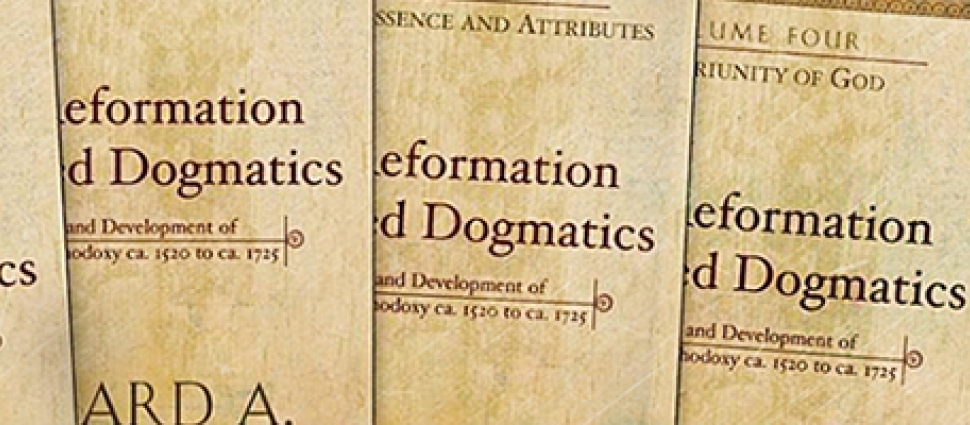A Year in PRRD (Week 1)

 Every Wednesday in 2018 Michael Lynch (PhD candidate at Calvin Theological Seminary) and our own editor Danny Hyde (PhD candidate at Vrije Universiteit Amsterdam) will be blogging through Richard Muller’s Post-Reformation Reformed Dogmatics, 4 vols. (2nd edition, Grand Rapids: Baker Academic, 2003).
Every Wednesday in 2018 Michael Lynch (PhD candidate at Calvin Theological Seminary) and our own editor Danny Hyde (PhD candidate at Vrije Universiteit Amsterdam) will be blogging through Richard Muller’s Post-Reformation Reformed Dogmatics, 4 vols. (2nd edition, Grand Rapids: Baker Academic, 2003).
These volumes are currently out-of-print but used copies can be found online here. For a schedule of weekly readings, go here.
Week 1 (1/1–1/7): I.1.1.1 (pgs. 27–46)
The crowning achievement of Richard Muller’s work on early modern theology is undoubtedly his four-volume Post-Reformation Reformed Dogmatics which are currently in the process of being updated and expanded for a third edition. This year, marking the 400th anniversary of the beginning of the Synod of Dort (1618–1619) and the 501st anniversary of the Reformation, makes for a fitting time to read through Muller’s magnum opus. For those participating, these weekly posts will help to elucidate some of the more important or interesting points found in each week’s reading. It will also give us a chance to think critically about Muller’s interpretation of the Reformed orthodox (hereafter, RO), especially at those junctures where subsequent scholarship has either objected, or (more typically) further enhanced Muller’s sketch of early modern RO.
This week’s reading (it’s never too late to begin…it’s Muller after all!) is an introduction to the series as a whole as well as to the first volume focusing on the nature of RO prolegomena. A few brief remarks are in order.
First, I hope you read the two prefaces for the first and second edition. Prefaces can tell you a lot about both the author and the book! When Muller wrote the first edition of PRRD his access to primary sources was much more limited than in the early 2000s. By that point access to databases like Early English Books Online was available. One of Muller’s most important methodological points is that one can only truly understand and appreciate the theology of the RO when one has read widely—their contemporaries and their theological forbearers (the patristics and medievals). How can one give a “broad description of what Reformed orthodoxy in fact was” (I.16) unless he or she has read widely?
Second, in the preface to the first edition (I.20–21), did you notice that Muller thanked Brian Armstrong (d. 2011) “for hours of enlightening discussion and for several important references to Protestant orthodox authors and their writings?” Who was Brian Armstrong? He has been one of Muller’s favorite foils in light of Armstrong’s negative treatment of scholasticism. Yet despite such strong polemic Muller thanks him! Of course, there are numerous lessons here. You cannot blame Muller for not listening to Armstrong. He had, we are told, “hours of enlightened discussion.” In short, Muller listened to his detractors. But—and I find this to be even more notable—Muller clearly respected Armstrong as a scholar. Muller thanked Armstrong for making him a better historian. As a young historian of theology, I am thankful for both scholars.
Finally, one other element in these introductory pages is worth highlighting. Muller’s anti-“Calvin vs. the Calvinists” thesis is often (mis)characterized as presenting a monolithic Reformed faith that never changed, was never modified, and hardly allowed for any disagreement within the tradition. Those who say such things, apart from having completely ignored some of Muller’s most recent publications, must have also ignored these introductory sections. Not only does Muller (as we saw in the preface to the second edition!) attempt to paint a wide and diverse picture of early modern RO in its various ecclesiastical, geographical, and confessional expressions, but he, in fact, admits that the RO tinkered with the theology and method of doing theology bequeathed to them by the Reformers:
“If by [the use of the term] Calvinist, one means a later exponent of a theology standing within the confessional boundaries described by such documents as [list of some significant Reformed confessions] ... then one will have the problem accounting for the many ways in which such thinkers [list of many well-known RO theologians] ... differ from Calvin both doctrinally and methodologically.” (I.30)
Muller is sensitive to the ways in which the RO modified the theology of the tradition that came before them. The methodological point at issue in Muller’s PRRD is how one ought to go about identifying and tracing such discontinuities (and continuities).
I do hope these brief thoughts whet your appetite to read more Muller. More so, however, I hope that reading Muller’s PRRD whets your appetite to read the Reformers and RO themselves. After all, if that is not the outcome of reading through Muller’s four-volumes, I can assure you that he would find such an endeavor to read through his four-volumes largely useless—after all, there really is no substitute for understanding the RO than reading the primary sources. To that end, Muller is a helpful and able guide for navigating the often-complicated early modern Reformed theological world. Tollite legite.
Join us next Wednesday as Danny Hyde blogs through the reading for Week 2 (1/8-1/14): I.1.1.2–3 (pgs. 46–84)!





